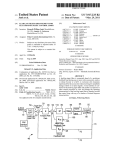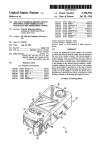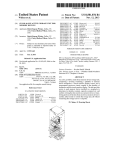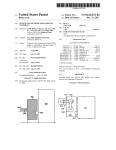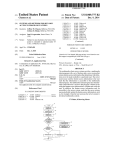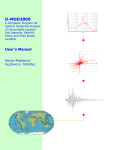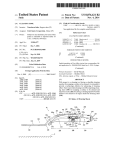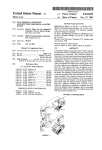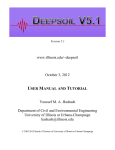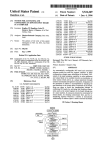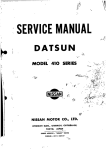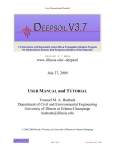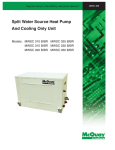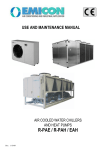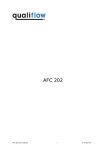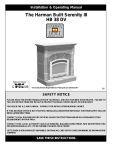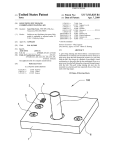Download llllllllllllllIIIllillllllllllllllllllllllllllllllllllllllllllllllllllllll
Transcript
llllllllllllllIIIllillllllllllllllllllllllllllllllllllllllllllllllllllllll USO05533544A Unlt€d States Patent [19] [11] Patent Number: Good et al. [45] [54] 5 9 533 9 544 Date of Patent: Jul. 9, 1996 SUPPLY BIASED PNEUMATIC PRESSURE 4,898,200 2/1990 Odajima et al. .. RELAY 4,928,530 5/1990 Lehto etal . 137/487.5 X . .. . .. . . . . .. 4,970,898 11/1990 Walish et a1 [75] Inventors: Stanley R. Good; Barry L. Gaarder, , both of Marshamown’ Iowa , gum‘; I'CSCO “It e . 5,172,713 [73] Assignee: Fisher Controls International, Inc., 73/756 73/706 .. 12/1992 Hall ................................... .. 251/367 X FOREIGN PATENT DOCUMENTS Clayton, Mo. .. _ [21] APP1- N°-- 456,243 [22] Filed: May 31’ 1995 0464966A1 3/1991 European Pat. Off. . 0442033Al 8/1991 European Pat. Off. . 2647522Al 11/1990 France. WO92/22860 12/1992 WIPO. _ _ OTHER PUBLICATIONS Related US. Application Data [60] Division of Ser. No. 114,955, Aug. 31, 1993, Pat. No. User’s Manual for the Model 3311 “Current—to—Pressure (I/P) Transducer”, Publication No. 4595, Rosemount Mea gts‘g39éo2ltgwllligcghzisg ctzimimtliation-in-paft 0f Ser- N°~ 942’ surement Control Analytical Valves, Sep. 1990, pp. 3—2, , Op.6 , , a an 011E . [2;] ................................................... .. GOSDgg/gg [ 1 [58] _' ' ' Field of Search ............................................... .. 137/85 [56] References Cited Primary Examiner_ Ger31 d A. Michalsky Attorney, Agent, or Firm-Marshall, 0’T6616, Gerstein, Murray & Bonm [57] US. PATENT DOCUMENTS ABSTRACT An electro-pneumatic converter device with modular com L180’897 4/1916 Williams . gonents argd witlziiupportmg‘glouimg structure enabling the 2,666,278 1/1954 Matasovic ......................... .. 137/557 X 3,123,094 3/1964 Toschko?" .. 137/50513 3,245,619 4/1966 “We 1° 6 Tea 1 Y °°nvem 6 Tom a current 1° Pressure pos1t1oner 19 a cu?em t0 Pr¢$§11rc tr?nsqucer- A valve Kramer _ _ _ _ _ _ _ _ _ __ 137135 X pos1t1oner with an enclosure having a houslng, a modular 3,334,642 8/1967 'Borthwick .. 3,349,787 10/1967 Thieme 137/85 137/85 base, and a separable ?eld terminal box. A self contained cover mounted to the enclosure with no additional mounting 3,842,679 10/ 1974 lwaqet a1 4,172,388 10/1979 Gabmlson 73/423 A 73/721 components. Aplastic pneumatic relay ultrasonically welded together to eliminate metal mounting parts and lower assem 31:25:21‘ '' ' ' ''‘ 4,239,182 12,1980 Amold et a1_ ‘ 4,315,432 2/1982 4,329,910 4,399,336 4,453,559 5/1982 Olsen et al. ..... .. 8/1983 dc versterre et a1 6/1984 Vamum .. Newton . . . . . . . . . . ''‘" bly time. Open channels in a_ housing surface cooperating 251/612 . . . .. 73/431 glth‘a gasgeth to priniideb?uldppassageways between the ousmg an t 6 m0 ‘1 ax ‘188 TBS/sure gauges are remov' 91/375 R 137/437_5 137/85 ably mounted 911 a modular ufllt for loci/H1011 qompletely within the houslng. A ?oating interconnect terrmnal board permits self-aligning of mating terminals as the modular unit 4,627,286 12/1986 Pehlgrim 73/431 is inserted into the housing. A supply biased pneumatic ‘£653,330 73/756 P ressure relay has supply pressure channeled to the supply 3/ 1937 Hedtke grown , , rown port and also to a supply bias cavity through a capillary hole. ..................................... .. 4,819,543 4/1989 Leinen ................................ .. 91/363 R 4,855,659 8/1989 Riensche ............................. .. 137/85 X <- EXHAUST \ 4 Claims, 14 Drawing Sheets US. Patent Jul. 9, 1996 Sheet 1 0f 14 5,533,544 US. Patent Jul. 9, 1996 Sheet 2 of 14 5,533,544 US. Patent Jul. 9, 1996 Sheet 3 of 14 F165 5,533,544 US. Patent Jul. 9, 1996 Sheet 4 of 14 H64 5,533,544 US. Patent Jul. 9, 1996 FIG4A 48 ) Sheet 5 0f 14 5,533,544 US. Patent F168 Jul. 9, 1996 Sheet 6 0f 14 5,533,544 US. Patent Jul. 9, 1996 Sheet 7 0f 14 @QE % l52:6' 5,533,544 US. Patent Jul. 9, 1996 Sheet 8 of 14 F/G. /O 5,533,544 US. Patent Jul. 9, 1996 Sheet 9 of 14 5,533,544 F/G..// ZOO \ 204 2/0 266 384 262 392 406 404 400 4/0 402 US. Patent Jul. 9, 1996 Sheet 10 0f 14 5,533,544 US. Patent EAF/G. 206 Jul. 9, 1996 Sheet 11 of 14 5,533,544 U.S. Patent Jul. 9, 1996 Sheet 12 0f 14 5,533,544 F/G. /5 354 230 D r P 344 262 264-\ i F/G /4 258 350 348 ‘i 206 t / ML‘! | I I 4! ' 274 272 W‘ / 304 ~_% 09259; ‘A PRESSURE J 258 ) 336 2 / _3O6 l I 354 \ I 230 SUPPLY PRESSURE 5,533,544 1 2 SUPPLY BIASED PNEUMATIC PRESSURE RELAY linkage with the valve stem. Both analog valve positioner units and digital valve controller units are separately avail able. This is a divisional of application Ser. No. 08/114,955, ?led Aug. 31, 1993, now U.S. Pat. No. 5,439,021, which is Typically, the customer chooses the type of instrument needed in order to ?t within his present system. Thus, a customer may initially choose to purchase a pressure trans— a continuation-in-part of application Ser. No. 07/942,758, ?led Sep. 9, 1992, abandoned. This invention relates to pressure relay devices and in particular to supply biased pneumatic pressure relays useful in current to pressure transducers and valve positioner devices. 10 chased a pressure transducer instrument, he must purchase a new valve positioner device in the proper data format to ?t BACKGROUND OF THE INVENTION Electro-pneumatic converters, such as current to pressure his changed system. transducers are in common use as ?eld instruments mounted It is therefore further desired to provide an electro in pipeline systems for controlling the process ?uid. Sub pneumatic instrument which is usable and readily convert sequently these devices are installed in potentially hazardous explosive environments. Such devices receive, for example, a variable current input signal of between 4-20 mA and eventually provide a variable pressure output to an actuator 20 ible from a pressure transducer to a valve positioner or vice versa. In addition, it is desired to enable a user to readily convert from an analog data handling capability to a digital data handling capability or vice versa. Furthermore, it is for a ?uid control valve. Since these devices can be employed in a potentially explosive environment, to provide an explosion proof device the electrical and pneumatic components are isolated within an explosion proof portion ducer instrument in analog form as most conveniently adaptable to his present system. If the customer’s system changes or he wishes to modify his system to operate in digital form, the customer must then purchase the required separate instruments. Also, if the customer wants to change to a valve positioner con?guration when he initially pur desired to enable the instrument user to incorporate and to change to any desired communications data protocol. 25 of the transducer/positioner unit, except for the pressure In existing electro-pneumatic instruments, the instrument housing is usually formed of a casting. The casting must then be drilled with precise holes to form passageways and gauges which are normally located on the unit exterior. interconnected passageways to enable the desired commu~ With presently available electro-pneumatic converters operating in a potentially explosively hazardous area, in the nication of ?uid between components. Forming of the event either service of the unit or normal maintenance is 30 required, the electric power must be disconnected and/or the entire unit must be removed from the potentially hazardous desired passageways by drilling intersecting holes in the casting requires time consuming precision drilling and set up of the housings for drilling. Present instruments also utilize many individual sub-assembly components requiring stock area in order to be worked on. Occasionally, for instance, the ing and assembly time. The instrument covers, for instance, pneumatic elements must be adjusted or removed and normally require two or more pins and locks or other replaced. In present units, if the seal of the explosion proof 35 multi-part fasteners to mount the cover to the instrument. portion of the unit is removed in order to get access to these This requires an inventory of the several parts and an pneumatic elements, then a potentially unsafe condition is created where any spark caused in the electrical elements inordinate amount of assembly time to assemble the cover to the instrument. could ignite potentially explosive gases. Accordingly, shut ting down the electrical power in order to service or remove 40 the unit from the hazardous area is time consuming, costly, based materials. Machine screws are used to assemble the and wasteful. In addition, with the electrical and pneumatic components maintained within an explosion proof portion of the trans ducer/positioner unit, the mounting of the pressure gauges on the portion outside the explosion proof portion of the unit is required. However, this exposes the pressure gauges to the atmosphere as well as to physical damage from uninten tional blows to the pressure gauges protruding even slightly from the transducer/positioner exterior surface. Accordingly, it is desired to provide an electro-pneumatic Pneumatic relays, used extensively in positioners and transducers, normally have been made from aluminum aluminum relay body components together while clamping rubber diaphragms and O-rings to provide the pressure seals. Assembly of these numerous sub-assembly components of present pneumatic relays is tedious and costly in the manu facturing environment. It is desired therefore to eliminate components or at least reduce the number of components required for an electro 50 pneumatic instrument. SUMMARY OF THE INVENTION converter which can be used in a potentially explosive In accordance with the present invention there is provided environment and wherein pneumatic components can be serviced without requiring electrical shutdown or removal of 55 a versatile modular con?guration for an electro-pneumatic the entire unit from the hazardous area. instrument that can serve as a platform of construction for a In addition, it is desired to provide an electro~pneumatic converter where the pressure gauges can be protected from the atmosphere as well as from any unintentional physical wide range of output devices which includes, for example: a digital pressure transducer; a digital valve controller; an analog valve positioner; and an analog pressure transducer. All of the aforementioned output devices available from the present invention can provide the following features: damage. 60 Currently available pressure transducer instruments con 1. A modular con?guration with a ?eld termination com partment, an electronics compartment, and a pneumatic tain a pressure to current sensor to convert a pressure signal to a current signal in supplying feedback to the instrument. Analog pressure transducer units are available, as well as respective digital pressure transducer units. Also currently available are separate valve positioner units which incorpo rate feedback from the valve supplied from a mechanical 65 compartment which are all environmentally segregated from each other; 2. A modular con?guration which is explosion proof, and allows maintenance and serviceability of the pneumatic 5,533,544 3 4 elements without interfering with the electrical components; a closed con?guration and yet can be readily removed from the module base if desired in an open con?guration. In accordance with a further aspect of the present inven and 3. A modular con?guration permitting user selected varia tions in feedback and mountings to accommodate both sliding stem valve actuators and rotary shaft valve actuators. tion, there is provided a pneumatic relay with plastic molded structural body components. These components are ultra sonically welded together in a manner that clamps the diaphragm to provide the pressure seals, thus eliminating the need for machine screws. Thus, the number of sub~assembly components are minimized and the assembly costs for the In accordance with the principles of the present invention, there is provided an electro-pneumatic instrument of modu» lar construction which is readily convertible from a pressure transducer to a valve positioner and vice versa. In the preferred embodiment of the invention, the convertible pneumatic relay are drastically reduced by almost one-half. instrument includes an enclosure having a housing de?ning a hollow interior, and a modular base containing electrical and pneumatic components, where the modular base is There is also provided an electro'pneumatic converter in the form of a current to pressure transducer/positioner unit having an enclosure which includes a housing and module removably insertable into the housing. A housing portion is included on the housing and is adapted for receiving and mounting therein a potentiometer and shaft in converting the 15 instrument to a valve positioner. The housing portion com municates with the hollow interior to enable the potentiom eter output to be connected to the electrical components on the modular base via the housing portion and the housing direction. This segregated compartment preferably contains the electrical components. Another segregatedv compartment The housing portion may be formed of an elongated cylindrical boss extending along the housing and which is de?ned between the dividing interior wall and a second includes a pocket interior to receive the potentiometer at one 25 interior and a bushing is threadably mounted on the elon portion of the module base opposite the dividing interior wall in a second direction opposite from the ?rst direction for preferably containing the pneumatic components iso gated cylindrical boss to supportably mount the potentiom lated from the electrical components. A removable cover is preferably provided for the segre eter shaft. In converting a valve positioner utilizing the present gated compartment containing the pneumatic components. electro-pneumatic instrument of the present invention to a pressure transducer, this can be readily provided by remov Accordingly, removing the cover enables access to the ing the potentiometer from the housing portion, disconnect ing the potentiometer output cable from the main printed circuit board mounted on the modular base, and replacing the main circuit board to accommodate the signals appro— partmented portion of the unit forming two segregated compartments for the respective electrical and pneumatic components. A dividing interior wall between opposite sides of the module base de?nes a segregated compartment between the dividing interior wall and a ?rst portion of the module base opposite the dividing interior wall in a ?rst hollow interior. end. The pocket interior intersects with the housing hollow base for electrical and pneumatic components with a com 35 pneumatic component segregated compartment for servicing the pneumatic components while maintaining the electrical components isolated. Therefore, with the present invention, the explosion proof electronic compartment remains isolated and undisturbed and all of the explosion proof elements can remain intact while one services the pneumatic elements in The preferred embodiment also includes an electrical the unit of the present invention. Thus, there is no need to terminal box mounted on the housing with a passageway disconnect the electrical power while working on the pneu between the housing interior and the terminal box. An 40 matic elements in the unit of the present invention. electrical terminal board is replaceably mounted in the The signi?cant advantage of this aspect of the invention terminal box which includes a removable cover for access includes the ability to adjust or remove and replace the thereto. A cable harness is connected to the electrical ter pneumatic elements while the power is connected without minal board in the terminal box and extends through the breaking the seal of the explosion proof portion of the passageway and the housing hollow interior for connection 45 transducer/positioner. Other signi?cant advantages include to the main circuit board on the modular base. The terminal the ability to provide additional maintenance features, such board and cable harness are replaceable to accommodate as stroking the pneumatic elements fully opened or closed to corresponding desired formats and functions, such as ana perform maintenance diagnosis of the unit. The pneumatic log, digital, communication or data protocols. elements can also be adjusted to change pneumatic zero In accordance with another aspect of the present inven 50 during maintenance or troubleshooting. Also, access to the priate to a pressure transducer as is known in the art. tion, a housing is provided with a substantially ?at housing supply pressure primary restriction which may become clogged and requires cleanout is readily provided in accor mounting surface with open channels or slots within the surface. A modular base has a modular base mounting surface opposite to the housing mounting surface. A gasket is provided intermediate the housing mounting surface and the modular base mounting surface. The gasket covers the open channels so as to de?ne the housing ?uid passageways, 55 dance with this invention. In accordance with another aspect of the present inven tion, an electro-pneumatic converter unit includes an enclo sure having a housing de?ning a hollow interior and a modular base removably insertable into the housing hollow and further includes apertures for communicating the hous interior so as to be surrounded by the enclosure. Electrical ing ?uid passageways to the modular base ?uid passage and pneumatic converter components are mounted on the ways. A distinct advantage of this aspect of the invention is 60 modular base including one or more pressure gauges so that the elimination of the need to drill precise holes through the the pressure gauges are located within the enclosure and housing or to precisely locate and drill intersecting holes to thereby protected from the environment and any physical form the desired ?uid communicating passageways. damage. The gauges, which are mounted in the pneumatic In accordance with still another aspect of the present compartment are in an atmosphere which is constantly being invention, there is provided a cover with self-contained 65 purged by the supply pressure medium, thus aifording them mounting ears shaped for ease of inserting the ears into the additional protection to corrosive atmospheres not seen with module base so the cover is retained on the module base in devices with externally mounted pressure gauges. The pres * 5,533,544 5 6 sure gauges are preferably threadably mounted on the modu FIGS. 12 and 12A are exploded perspective views of the modular con?gured valve positioner of FIG. 10, the two lar base for ease in servicing and replacement. In accordance with still another aspect of the present invention, the modular base includes a dividing interior wall. First means are provided for mounting the electrical com III ponents on one side of the dividing interior wall. Second means are provided for mounting the pneumatic components including pressure gauges on the opposite side of the divid ing interior wall. Accordingly, as the modular base is insert ably mounted into the housing interior, segregated compart— 10 ments are de?ned for respectively isolating the electrical components from the pneumatic components. In accordance with still another aspect of the invention there is provided an improved pneumatic pressure relay for arrowheads; FIG. 13 is an elevational view showing a modular base with some components removed for clarity; FIG. 14 is a sectional view taken along section lines 14—14 of the modular base shown in FIG. 13; FIG. 15 is a fragmented view partly in section showing a pressure sensor sensing the output pressure; FIG. 16 is an elevational view of the instrument housing portion showing channels in the surface for ?uid passage ways; FIG. 17 is an elevational view of the modular base a ?uid actuator control valve assembly. The supply pressure is communicated to a supply bias cavity through a capillary hole to maintain a substantially constant supply pressure of the relay. Pressure transients in response to load changes are isolated from the supply bias cavity by the capillary hole. ?gures being consecutively locatable along the same central reference axis along the direction indicated by the respective 20 showing the modular base surface facing the housing surface of FIG. 16; and FIG. 18 is a schematic block diagram illustrating the electro-pneumatic converter instrument readily convertible from a valve positioner to a pressure transducer and vice BRIEF DESCRIPTION OF THE DRAWINGS versa. The features of this invention which are believed to be novel are set forth with particularity in the appended claims. The invention may be best understood by reference to the following description taken in conjunction with the accom panying drawings, in which like reference numerals identify like elements in the several ?gures and in which: DETAILED DESCRIPTION 25 The modular and convertible aspect of the invention illustrated in FIGS. 1—9 will be described in connection with an embodiment comprising a current to pressure transducer. It is to be understood that the teachings herein can as well FIG. 1 is a front elevational view illustrating a current to 30 be applied to other electro-pneumatic converter devices to solve problems similar to those which are solved by the pressure transducer having an enclosure with a housing and present invention. As an example, while this description is in a removable module base in accordance with the present connection with a current to pressure transducer, it is well invention; known in the art that such devices can readily be converted FIG. 2 is a cross-sectional view taken along section lines 2—2 of the current to pressure transducer shown in FIG. 1, 35 to a current to pressure positioner following the teachings herein. with certain components removed for clarity; The ?exible modular and convertible aspect of the inven FIG. 3 is a sectional view of the module taken along tion illustrated in FIGS. 10-18 will be described in connec section lines 3—-3 of the current to pressure transducer tion with a preferred embodiment comprising a current to shown in FIG. 1, with certain components removed for pressure positioner which is more readily convertible to a clarity; current to pressure transducer and vice versa than the FIG. 4 is a sectional view taken along section lines 4-—4 of the current to pressure transducer shown in FIG. 2, with embodiment of FIGS. 1—9. Accordingly, the present descrip~ certain components removed for clarity; FIG. 4A is a fragmentary sectional view taken along 45 section lines 4A——4A of the current to pressure transducer shown in FIG. 1; FIG. 5 is a fragmented sectional view taken along section lines 5——5 of the current to pressure transducer shown in the teachings herein. I. Convertible Current To Pressure Transducer FIG. 1, with certain components removed for clarity; Refening now to FIGS. 1 and 2, there is illustrated a current to pressure transducer 10 having an enclosure which includes a housing 12 with one portion de?ning a hollow interior 14. The housing 12 includes a ?eld terminal box FIG. 6 is an elevational view showing an interconnect board for connecting electrical terminals; FIG. 7 is an elevational view showing the interior of the housing with the interconnect board ?oatably mounted therein; 55 from the housing so that the appropriate cable wiring 60 FIG. 10 is a perspective view of a preferred embodiment of the invention illustrating a valve positioner in modular con?guration which can be readily converted to a pressure transducer; FIG. 11 is a sectional view of the preferred embodiment of the invention taken along section lines 11—l1 of the valve positioner shown in FIG. 10; portion 16 including a ?eld terminal strip 18 for suitable connection to an electrical signal cable for receiving a current control signal from a distributing control system, so as to for instance monitor a process. End cap 20 is removable FIG. 8 is a schematic sectional view showing a shoulder screw mounting the interconnect board in a ?oating manner; FIG. 9 is a sectional view showing a supply biased pneumatic pressure relay; tion is to be understood to be for purposes of describing the preferred embodiment and is not meant to limit the scope of the invention and the claims. Thus, the invention and the claims are to be given a broad interpretation consistent with 65 connections can be made to terminal 18. Housing 12 also includes an inlet 22 for receiving a supply pressure from a pneumatic supply source, and an outlet port 24 through which the output pressure can be suitably coupled to a positioner or directly to a valve actuator. Typically, in response to a variable 4—2O mA current control signal, current to pressure transducer 10 provides a variable pressure output at outlet 24. 5,533,544 7 8 A modular base 26 (see FIG. 3) contains the electrical components and the pneumatic components for current to pressure transducer 10. Typically, this will consist of a mount and seal the metal base 28 through O-rings 32 with respect to housing 12. In accordance with one aspect of the present invention, it may be noted that while the pressure components and the electrical components have been isolated within the enclo sure formed by housing 12 and modular base 26 to prevent any inadvertent spark from the electrical components to current to pressure converter device such as a I/P nozzle block having a ?apper for converting the variable current control signal input into a variable nozzle pressure signal; a pressure relay receiving the variable nozzle pressure signal and providing a variable pressure output on outlet 24; a ignite potentially hazardous environments which may be pressure gauge monitoring the supply pressure coupled to inlet port 22; a second pressure gauge monitoring the present in the pressure components, yet the pressure com ponents can be serviced and maintained without shutting pressure output on outlet 24; and electronic equipment such down the power or requiring removal of unit 10 from the as a pressure sensor and a printed circuit board with circuitry potentially hazardous area. With respect to this aspect of the to process the electrical signals as required. present invention, note that removal of cover 38 and mask Modular base 26 includes a metal base 28 having a 36 from the enclosure provides access to the pressure threaded ring 30 and O-rings 32 so that modular base 26 can components within pressure compartment 40 while still be inserted into housing 12 by threadable engagement. 15 maintaining the isolation of the electrical components in Reference may be made to FIG. 2, wherein modular base 26 electrical compartment 42. is shown in its complete threadable mounting position when fully inserted within housing 12. Thus, the UP nozzle block 46 can be serviced without turning o?’ the electrical power. For instance, the pneumatic The modular base also includes a modular wall 34 which provides the mounting of the pressure components on one side and the electrical components on the other side. In the modular base 26, and opposite wall 34, there is provided a masking plate 36 and a clear cover plate 38 forming a pressure compartment 40 in the modular base and de?ned between modular wall 34 and cover plate 38. With reference elements can be adjusted to pneumatic zero during mainte nance or troubleshooting by affording access to a zero to FIG. 2, it can be seen that when the modular base is adjustment nut 70 on the UP nozzle block unit. Also, access is permitted to a cleanout wire 72 to permit the wire to be used to cleanup the pneumatic restriction or ori?ce in the air supply line which can become clogged. In a similar manner, the pressure gauges can be threadably removed from the insertably mounted into the housing, an electrical compart ment 42 is de?ned as part of housing interior 14 and is speci?cally de?ned between modular wall 34 and a housing side 44. module and replaced, if necessary, without shutting o?’ the power supply. Servicing of the pneumatic relay can also be performed with the complete isolation of the electrical components in electrical compartment 42. 25 30 With reference to FIGS. 1-3 it can be seen that the pressure components are mounted in the modular base on In accordance with another aspect of the present inven tion, it may be noted that pressure gauges 50 and 52 are one side of modular wall 34 and the electrical components are mounted on the other side of wall 34. For example, an mounted totally within the enclosure formed by housing 12 HP nozzle block-?apper unit 46, a pneumatic relay 48, and 35 pressure gauges 50, 52 are all mounted in pneumatic com partment 40 on one side of wall 34. A printed circuit board 54 containing electrical components and a pressure sensor 56 are mounted on the opposite side of modular wall 34 so that they are con?ned within electrical compartment 42 and modular base 26 so they are not subject to the environ ment or to any physical damage from actions outside of the housing. Yet, the pressure gauges can be removed or are subject to repair by removing replaceable cover 38 and mask 36 to provide access to pressure compartment 40. FIG. 4 illustrates the modular wall 34 which contains a longitudinal passageway to communicate the inlet pneu matic supply at an inlet end 76 into I/P nozzle block 46 and to communicate the UP nozzle block variable pressure when the modular base is inserted into the housing. Accordingly, as can be seen from FIG. 2, the electronic output into the pneumatic relay 48. Referring now to FIG. components are isolated within segregated electrical com partment 42 and the pressure components are isolated in 45 4A, there is illustrated modular wall 34 and the passageways through the modular base for connecting the supply pressure segregated pressure compartment 40 on opposite sides of from inlet end 76 to passageways 77 and 79 to the UP nozzle modular wall 34. All of the electrical and pneumatic com block 46 from the main supply passage 81. The variable ponents, including the pressure gauges, are maintained pressure output of nozzle block 46 is supplied through a within the instrument enclosure. It is understood, of course, passageway 83 to interconnecting passageway 74 to the that suitable explosion preventing devices are inserted in the ori?ces through wall 34 which may otherwise interconnect pneumatic relay 48. compartments 40 and 42. As an example, with reference to With reference to FIG. 3, it can be seen that passageway 81 connects to a transverse passageway 85 at the inlet end FIG. 3, aperture 58 through wall 34 interconnects pressure gauge 52 and pressure sensor 56. A commercially available item known as a ?ame arrester 60 is inserted in aperture 58. The ?ame arrester 60 may comprise a porous metal plug which allows pressure to pass through the plug but which will cool and lower the temperature of any ?ame in aperture 76 for eventual communication with inlet port 22 for receiv— 55 58 to prevent ignition of potentially hazardous environ ments. 60 Threaded ring 30 is free to rotate with respect to metal base 28. The threaded ring is securely captured between engage a threaded housing portion 68 so as to securely With reference to FIG. 4, apertures 78 are shown in the modular wall to permit the electrical connections from printed circuit board 54 through the modular wall to the UP nozzle block. As indicated previously, these apertures also contain suitable explosion proof seals to isolate and prevent any sparks in electrical compartment 42 from causing igni tion of potentially hazardous environment through the wall metal base 28 on one side and two stanchions 62 mounted to metal base 28 and having a projecting ledge 64 slightly spaced from a rim 66 of threaded ring 30. This enables the threaded ring to rotate and threadably ing the pneumatic supply pressure when the modular unit is mounted in the housing. 65 34 and into pressure compartment 40. In accordance with another aspect of the present inven tion, the mating of connections between the housing termi nals and the modular terminals is provided by a blind 5,533,544 10 connection, i.e. automatically as modular base 26 is insert ably mounted into housing 12. The electronic components a potentiometer. For a transducer unit, a plug 120 is thread on printed circuit board 54 are electrically connected to a compartment 42. When the unit is to be used as a positioner, a potentiometer can be mounted in the electrical compart ment for electrical connection to connectors 118 and with ably mounted into housing side 44 to close off electrical modular terminal strip 80 containing modular terminals 82, which as shown in FIG. 5 consist of a plurality of male terminal pins. Printed circuit board 54 is mounted within a the potentiometer shaft extending through an aperture with suitable ?ame arresting devices in a plug. plastic cover 84, preferably by epoxy molding of all of the units within the plastic cover. Cover 84 is in turn mounted to modular wall 34 through the use of appropriate threaded screws 86. As shown in FIG. 5, modular terminals 82 Referring now to FIG. 9, there is illustrated an improved pneumatic pressure relay 48 which receives a variable protrude through cover 84 for engagement with female housing terminals 88 contained on a housing terminal strip pressure on outlet 124 coupled to pneumatic outlet 24 of housing 12 (see FIG. 1) for communication with a valve actuator. Relay 48 also includes a supply pressure inlet 126 coupled to the inlet 22 of housing 12 (see FIG. 1) for connection to a source of pneumatic supply pressure. Relay control pressure on inlet 122 and delivers a variable output 90 which in turn is mounted to a housing interconnect board 92. With reference to FIGS. 6 and 7, there is indicated the manner in which the housing interconnect board is ?oatably mounted so as to permit self-aligning of the board with the modular terminal pins. Housing side 44 includes a pair of upright ribs 94 each having a threaded aperture for receiving a respective mounting screw 96. Preferably, mounting 48 also includes an exhaust outlet 128. Pneumatic pressure relay 48 includes a supply bias por tion for establishing the start point of the pneumatic pressure input range at inlet 122 for a given supply pressure at inlet 20 screws 96 are shoulder screws so that the bottom of the shoulder butts against the rib and prevents further penetra tion of the shoulder screw into the threaded aperture of the rib. Referring to the schematic illustration of FIG. 8, this con?guration is illustrated in more detail. Threaded aperture 98 within rib 94 receives a threaded portion 100 of screw 96 until a shoulder 102 compressingly abuts against rib 94. As seen in FIG. 8, the length of shoulder 102 is greater in dimension than the width of housing interconnect board 92. Therefore, the housing interconnect board can ?oat longi tudinally along screw 96 and between the screw head and the top of rib 94. If desired, screw head 96 can be sized for this purpose or, a larger washer 106 may be utilized. In addition, apertures 104 in housing interconnect board 92 are made slightly larger in diameter than the diameter of shoulder 102. This permits the interconnect board to slightly move trans versally with respect to the screw. Thus, housing intercon nect board is securely captured by screw 96 and ribs 94 but is allowed to ?oat in position between the screw and the rib so that the housing terminals are self-aligned with the 25 movement of diaphragm 130 in response to the variable pressure input on inlet 122 controls the opening and closing of the input supply and exhaust ports. A valve rod 136 includes a supply valve plug 138 at one end and an exhaust valve plug 140 at the other end. A valve spring 142 seated against plug 138 and cap 144 normally maintains plug 138 seated against input supply port 132 as shown in FIG. 9. This blocks the supply pressure from inlet 126 from reaching the actuator outlet 124 which supply pressure otherwise would communicate through pas sageways 146, 148, through an open input supply port 132 and through a passageway 150 to actuator outlet 124. The drive coupling between input signal diaphragm 130 40 modular terminals during the insertable mounting of modu lar base 26 into the housing. To guide the modular terminals in the correct orientation with respect to the housing terminals, a longitudinal groove 108 is provided on the inside surface of the housing. Groove 108 matches an indexing pin 110 which is ?xed within the outer surface of metal base 28. Thus, in inserting modular base 26 into the housing, the modular base is rotated until indexing pin 110 is ?tted within longitudinal groove 108 to 126. The start point input pressure will change with chang ing supply pressures and therefore allows the relay 48 to operate at different supply pressures without hardware changes, such as bias springs. With reference to FIG. 9, it may be seen that relay 48 includes an input signal diaphragm 130, an input supply port 132, and an exhaust port 134. The 45 and valve rod 136 is provided through three intermediate diaphragm mounting bodies, namely an upper body 152, a middle body 154 and a lower body 156. An upper supply bias diaphragm 158 is captured between bodies 152, 154 and a lower supply bias diaphragm 160 is captured between middle block 154 and lower block 156. A supply bias cavity 162 is de?ned between diaphragms 158, 160, middle block 154 and an outer casing 155. A small capillary hole 164 through casing 155 communicates the supply bias cavity with supply pressure inlet 126 so that the 50 supply bias cavity is substantially always under the supply pressure. Thus, the supply pressure is not only channeled to correctly position modular terminals 82 with the housing input supply port 132, but also enters supply bias cavity 162 terminals 88. Thereafter, as threaded ring 30 is rotated to move the modular base into the housing, because of the via capillary hole 164. It is desirable that once the supply pressure is established in cavity 162, that it not change ?oating mounting of housing interconnect board 92, the female housing terminals 88 become self-aligned with the 55 male modular terminals 82 to achieve the ?nal electrical interconnection of the modular base with the housing inter connect board as shown in FIG. 5. during the operation of relay 48. Momentary ?uctuations in the supply pressure can result when supply port 132 is opened and closed. The capillary hole isolates the supply bias cavity from pressure transients created when valve plug 138 opens or closes supply port 132 in response to load A ?exible electrical cable 112 interconnects the housing 60 changes. This effectively stabilizes the valve assembly when brief pressure ?uctuations occur due to input signal changes interconnect board 92 with a small printed circuit board 114 which in turn is connected to a series of RFI ?lters 116 with the ?lters 116 connected through housing 12 to appropriate ?eld terminals 18. - Since the transducer unit can readily be converted to a 65 positioner as known in the art, housing interconnect board 92 also includes suitable connections 118 for connection to thereby resulting in improved performance. FIG. 9 illustrates relay 48 in its normal position. When an increasing variable pressure is coupled to inlet 122, input signal diaphragm 130 is ?exed upwardly in FIG. 9 to move bodies 156, 154, 152, exhaust plug 140, rod 136 and valve plug 138 also upwardly to unseat the supply port 132.
























